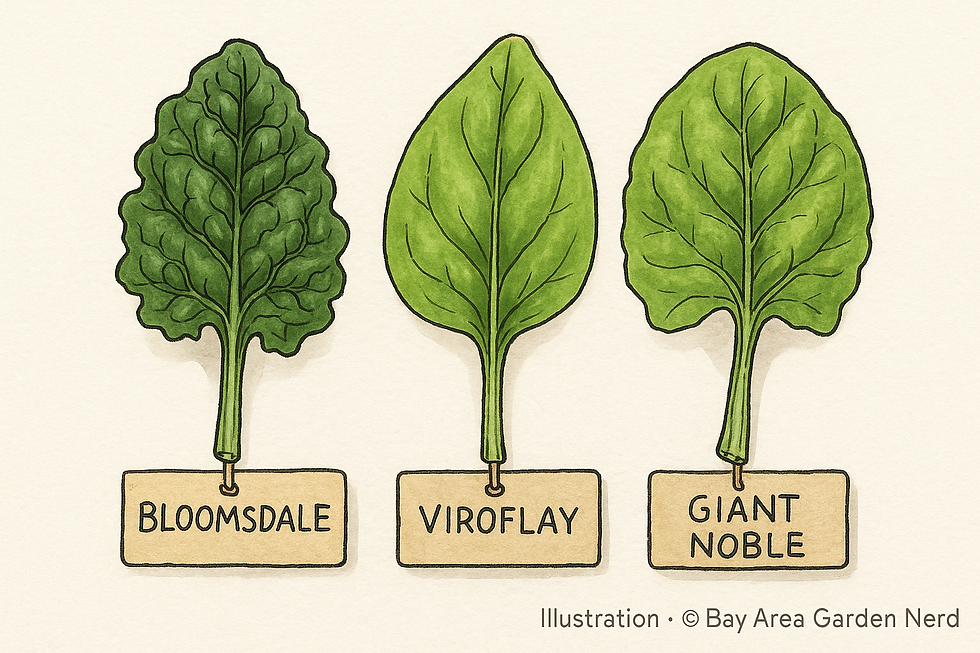Masterclass: Spinach — Bay Area (Sunset + USDA)
- Garden Nerd
- Aug 28
- 2 min read
Spinach is one of the most reliable cool‑season crops in the Bay Area — but dialing timing to your microclimate makes all the difference. This Masterclass uses Sunset zones (14–17 for most Bay Area gardeners) alongside USDA hardiness (9–10) so you can start seeds at the right moment, pick the best varieties, and stay ahead of downy mildew and leafminers.
Why both systems? USDA zones are based on winter minimums—great for knowing if a plant can survive—but they don’t capture marine fog, wind, or summer highs that drive bolt pressure and disease. Sunset zones account for total climate (length of season, rainfall timing, winter lows, summer highs, wind, humidity), which is why they’re the gold standard for Western gardeners and much more precise for Bay Area decisions.
In this guide, you’ll get a microclimate matrix for Sunset 14, 15, 16, and 17 mapped to USDA 9–10, plus exact sowing/transplant windows using data adapted for coastal, bayside, and inland conditions. We’ll layer in a weekly task list from prep to first harvest, targeted IPM actions tied to weather patterns, and a short list of heirloom varieties that hold well under our fog‑cooled mornings and sudden warm spells.
Sunset + USDA microclimate matrix (timing overview)
• Zone 17 (marine layer, coolest summers; USDA 10/9b pockets): Sow/transplant earlier in fall and later in spring; extended baby‑leaf season.
• Zone 16 (coastal thermal belts; USDA 9b–10a): Spring sowing mid‑window; fall sowing starts slightly earlier than inland.
• Zone 15 (coastal range with chilly winters; USDA 9b–10a): Similar to 16; watch winter lows in interior valleys.
• Zone 14 (inland with some ocean influence; USDA 9b): Spring sowings end earlier due to heat; fall is prime.
Bay Area planting windows
• Prime sow/transplant windows: Mar–May and Sep–Nov; use row cover to push edges if needed.
Weekly checklist (high level)
• Week 0: Prep bed with compost; pre‑irrigate.
• Week 1: Sow ½ in deep; keep evenly moist.
• Week 2–3: Thin to 4–6 in; deploy row cover if leafminers appear.
• Week 4–6: First baby harvest; side‑dress if growth slows.
• Week 6+: Continue cut‑and‑come‑again; scout for downy mildew after cool, wet spells.

Targeted IPM timing
• Downy mildew: highest risk during cool, humid stretches or persistent fog drip; water mornings, increase spacing, select resistant seed.
• Leafminers: peak as nearby greens mature; remove mined leaves promptly; rotate out of infested beds.

“GrowBot did some digging: coastal fog can keep leaf surfaces wet longer—great for growth, not so great for downy mildew. Airflow and morning watering help.”
Heirloom Varieties for the Bay Area
• ‘Bloomsdale Long Standing’ (savoyed, bolt‑tolerant for spring shoulder).
• ‘Viroflay/Monstrueux de Viroflay’ (large, fast baby‑leaf yields).
• ‘Giant Noble’ (broad leaves; reliable fall growth).

Local Notes:
San Mateo bayside (often Sunset 16/15, USDA 10a): fall sowings from late Sep perform best; spring sowings benefit from morning shade screens during warm spikes.



Comments